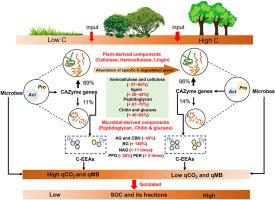当前位置:
X-MOL 学术
›
Soil Biol. Biochem.
›
论文详情
Our official English website, www.x-mol.net, welcomes your feedback! (Note: you will need to create a separate account there.)
Shifts in C-degradation genes and microbial metabolic activity with vegetation types affected the surface soil organic carbon pool
Soil Biology and Biochemistry ( IF 9.7 ) Pub Date : 2024-02-28 , DOI: 10.1016/j.soilbio.2024.109371 Qian Huang , Baorong Wang , Jikai Shen , Fengjing Xu , Na Li , Penghui Jia , Yongjian Jia , Shaoshan An , Isaac Dennis Amoah , Yimei Huang
Soil Biology and Biochemistry ( IF 9.7 ) Pub Date : 2024-02-28 , DOI: 10.1016/j.soilbio.2024.109371 Qian Huang , Baorong Wang , Jikai Shen , Fengjing Xu , Na Li , Penghui Jia , Yongjian Jia , Shaoshan An , Isaac Dennis Amoah , Yimei Huang

|
The incorporation of plant-derived biomass by microorganisms into deceased microbial biomass, i.e., a “microbial carbon pump”, is essential for forming a soil carbon (C) pool. Therefore, microbial communities and associated functions could shape the formation of soil organic C (SOC) composition and persistence. However, the mechanism by which microorganisms mediate the degradation of various types of biomass (such as plant or microbial) and its impact on SOC formation under different vegetation types remains unclear. Herein, we analyzed microbial communities, carbohydrate-activated enzymes (CAZymes), absolute quantification of C-degradation genes, and extracellular enzyme activities to track microbial-mediated SOC formation under three vegetation types on the Loess Plateau. Changes in vegetation type influenced microbial community structure and distributions of certain bacterial groups. Specifically, dominant bacterial taxa shifted from oligotrophic Actinobacteria to eutrophic Proteobacteria from grass to forest soil. The proportion of microbial CAZymes responsible for decomposing plant-derived components (86–89%) exceeded that of microbial-derived components (11–14%), suggesting a greater capacity for the degradation of deceased plant biomass by microorganisms. There was a reduction of 14%–17% in the absolute abundance of specific C-degradation genes for hemicellulose and cellulose in forest soil compared to grass, while an increase of 20%–32% was observed in lignin and chitin degradation. This indicated a higher decomposition potential of lignin and chitin by microorganisms in forest soil. The number of CAZymes genes involved in the degradation of bacteria-derived biomass (peptidoglycan) was higher than fungi-derived biomass (chitin and glucans) and had a close correlation with the qCO, microbial biomass C (MBC), and particulate organic C (POC). The abundance of C-degrading genes increased with the increase in the corresponding enzyme activity, indicating that enzyme activity is regulated by functional genes. In conclusion, shifts in CAZymes genes encoding for the degradation of diverse carbon sources could impact microbial metabolic activity through a microbial “carbon pump” regulation process. This mechanism could facilitate the formation of soil organic carbon and its fractions across different vegetation types.
中文翻译:

碳降解基因和微生物代谢活动随植被类型的变化影响了表层土壤有机碳库
微生物将植物来源的生物质掺入已死亡的微生物生物质中,即“微生物碳泵”,对于形成土壤碳(C)库至关重要。因此,微生物群落和相关功能可以影响土壤有机碳(SOC)的组成和持久性的形成。然而,微生物介导各类生物质(如植物或微生物)降解的机制及其对不同植被类型下SOC形成的影响仍不清楚。在此,我们分析了微生物群落、碳水化合物激活酶 (CAZymes)、C 降解基因的绝对定量和细胞外酶活性,以追踪黄土高原三种植被类型下微生物介导的 SOC 形成。植被类型的变化影响微生物群落结构和某些细菌群的分布。具体来说,从草地到森林土壤,优势细菌类群从寡营养放线菌转移到富营养变形菌。负责分解植物来源成分的微生物 CAZymes 比例 (86-89%) 超过了微生物来源成分 (11-14%),表明微生物降解死亡植物生物量的能力更大。与草相比,森林土壤中半纤维素和纤维素的特定 C 降解基因的绝对丰度减少了 14%–17%,而木质素和甲壳质降解基因的绝对丰度增加了 20%–32%。这表明森林土壤中微生物对木质素和甲壳素的分解潜力较高。参与细菌来源生物量(肽聚糖)降解的 CAZymes 基因数量高于真菌来源生物量(几丁质和葡聚糖),并且与 qCO、微生物生物量 C(MBC)和颗粒有机 C 密切相关(概念验证)。 C降解基因的丰度随着相应酶活性的增加而增加,表明酶活性受到功能基因的调节。总之,编码多种碳源降解的 CAZymes 基因的变化可能通过微生物“碳泵”调节过程影响微生物代谢活动。这种机制可以促进不同植被类型土壤有机碳及其组分的形成。
更新日期:2024-02-28
中文翻译:

碳降解基因和微生物代谢活动随植被类型的变化影响了表层土壤有机碳库
微生物将植物来源的生物质掺入已死亡的微生物生物质中,即“微生物碳泵”,对于形成土壤碳(C)库至关重要。因此,微生物群落和相关功能可以影响土壤有机碳(SOC)的组成和持久性的形成。然而,微生物介导各类生物质(如植物或微生物)降解的机制及其对不同植被类型下SOC形成的影响仍不清楚。在此,我们分析了微生物群落、碳水化合物激活酶 (CAZymes)、C 降解基因的绝对定量和细胞外酶活性,以追踪黄土高原三种植被类型下微生物介导的 SOC 形成。植被类型的变化影响微生物群落结构和某些细菌群的分布。具体来说,从草地到森林土壤,优势细菌类群从寡营养放线菌转移到富营养变形菌。负责分解植物来源成分的微生物 CAZymes 比例 (86-89%) 超过了微生物来源成分 (11-14%),表明微生物降解死亡植物生物量的能力更大。与草相比,森林土壤中半纤维素和纤维素的特定 C 降解基因的绝对丰度减少了 14%–17%,而木质素和甲壳质降解基因的绝对丰度增加了 20%–32%。这表明森林土壤中微生物对木质素和甲壳素的分解潜力较高。参与细菌来源生物量(肽聚糖)降解的 CAZymes 基因数量高于真菌来源生物量(几丁质和葡聚糖),并且与 qCO、微生物生物量 C(MBC)和颗粒有机 C 密切相关(概念验证)。 C降解基因的丰度随着相应酶活性的增加而增加,表明酶活性受到功能基因的调节。总之,编码多种碳源降解的 CAZymes 基因的变化可能通过微生物“碳泵”调节过程影响微生物代谢活动。这种机制可以促进不同植被类型土壤有机碳及其组分的形成。



























 京公网安备 11010802027423号
京公网安备 11010802027423号